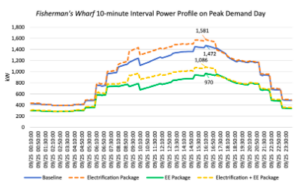June 2, 2023
Topic
California’s changing climate has brought intense drought, wildfire, and heat waves. San Francisco’s Climate Action Plan commits to transitioning building energy use to renewable electricity sources as part of efforts to reduce citywide carbon emissions 61% by 2030 and to net-zero by 2040. Is today’s electric grid ready for widespread building electrification?
Updating grid infrastructure is a slow, capital-intensive process influenced by stakeholders, utilities, and regulators. Utilities conduct analyses for planning and maintenance, but such data is usually not available to the public because it relies on customer energy use and sensitive details about infrastructure.
To provide timely and public insight, Lawrence Berkeley National Laboratory scientists developed methods to analyze the impacts of district-scale electrification using public records. Building energy models were prepared for 54 adjoining commercial buildings in two commercial districts in San Francisco: Fisherman’s Wharf and the Design District. The Design District is comprised of office and retail uses, while Fisherman’s Wharf is primarily hotel with retail and restaurants; gas is the primary source of space heating and service hot water. Characteristics of these hotels, offices, shops, and restaurants were gleaned from land use data, code vintage, and mandatory energy audits. Baseline energy use was calibrated with public energy benchmarking data. Capacity and utilization of existing electric grid infrastructure were obtained from Distribution Resource Planning maps published by PG&E.
Retrofit scenarios included: basic electrification, efficiency, and efficiency combined with electrification. Basic electrification used on-the-shelf technology like air source heat pumps. Energy efficiency measures were common such as LEDs, insulation, and demand-controlled ventilation. All-electric scenarios increased annual electric consumption, but due to the efficiency of heat pumps overall site energy use decreased 15% to 17% and reduced carbon emissions 37% to 46%.
Building load profiles were aggregated for each district to characterize annual 10-minute peak electric demand. Basic electrification increased peak electric demand in Fisherman’s Wharf 7% (largely due to electrification of hotel service hot water), but efficient electrification reduced peak demand 26% (Figure 1). Office and retail in the Design District use less service hot water, so even basic electrification slightly reduced district-scale peak demand. The analysis did not examine building-level infrastructure; peak demand was projected to increase for some buildings in each district. Such increases could require updates to service lines or switchgear and the study methods are not a substitute for utility engineering analysis.

Figure 1: 10-minute interval load profiles on the peak electric demand day for Fisherman’s Wharf
From public records, the study gleaned directional insights: Grid capacity data published by PG&E implies existing power infrastructure can accommodate comprehensive electrification in two districts. In addition, investment in energy efficiency at the district scale could reduce peak demand – which would greatly increase confidence today’s electric distribution is not a barrier to electrification, and potentially free up capacity to support other uses such as electric vehicle charging.
To learn more:
Hong T, et al (2023) Nexus of Electrification and Energy Efficiency Retrofit of Commercial Buildings at the District Scale, Sustainable Cities and Society Vol 95. https://doi.org/10.1016/j.scs.2023.104608





